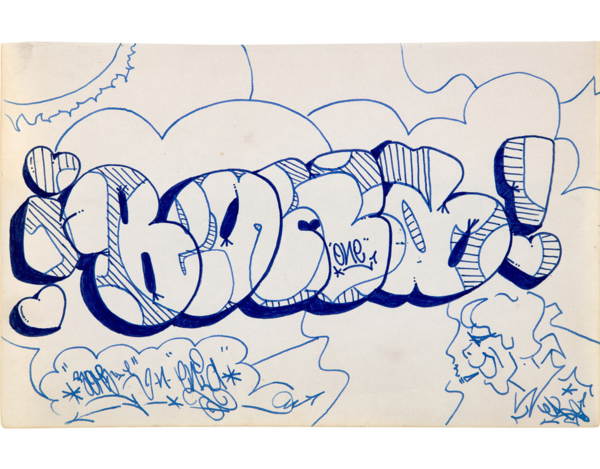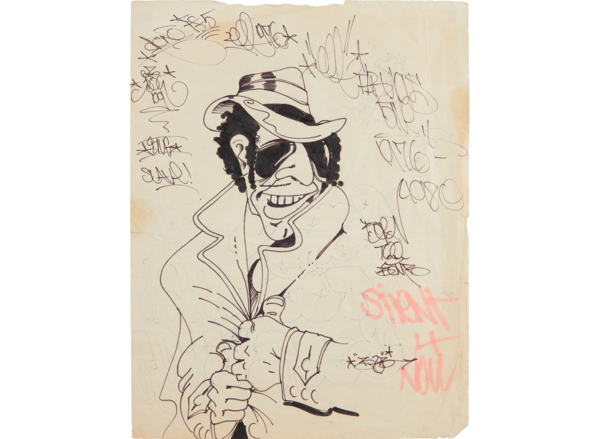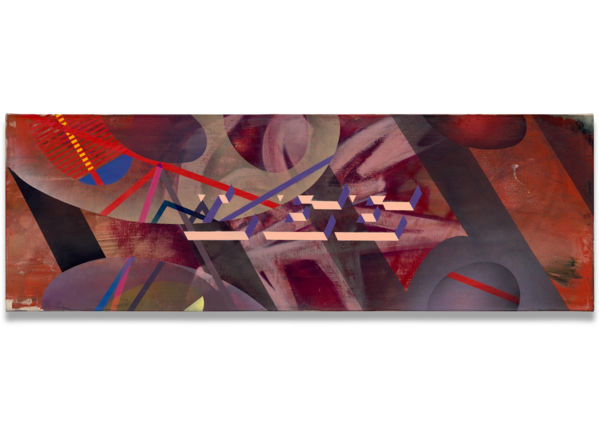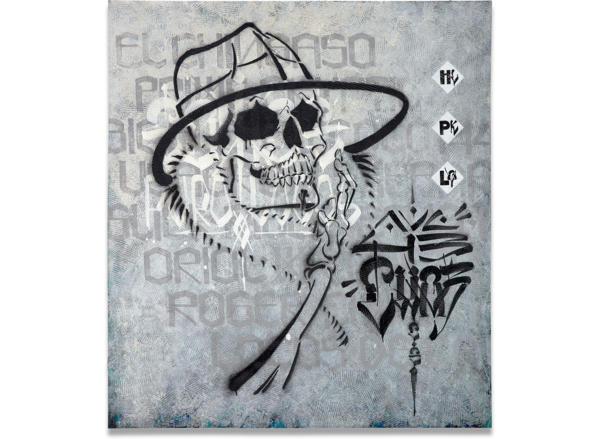Fred Brathwaite aka Fab 5 Freddy, Mr. Potato Head, 1983. 1970s / GRAFFITI / TODAY.
1970s / GRAFFITI / TODAY is a wide-ranging and fascinating overview of graffiti as both communication and art, as exemplified over the past half-century in New York and in Los Angeles. On view now at Phillips’ 432 Park Avenue gallery, the exceptional exhibition brings together the visual languages of both coasts with conversations between eras, styles, and artists. Chaz Bojórquez created his unique style in Los Angeles’ Chicano neighborhoods and expanded to the freeways and concrete riverbeds of the city in the 1960s as his stenciling technique developed into a passion. On the streets of New York, legends like Lee Quiñones, Al Díaz, and Fab 5 Freddy absorbed the uptown import tags of the early 1970s and found a practice of their own on walls and subway cars barreling up and down Manhattan. Phillips Senior Advisor Arnold Lehman speaks with the artists about everything from their personal histories to observations on the culture they helped launch, and how they still find the art of graffiti as thriving and fulfilling as it continues to evolve in the present day.
Part I: Al Díaz & Chaz Bojórquez
Part II: Lee Quiñones & Fab 5 Freddy
On the Early Days
AL DÍAZ: The first time I wrote graffiti, I was old enough to spell. I wrote a curse word in chalk in front of my building on Avenue D, and my mother saw it, smacked me, and said “that’s not nice!” I think it was in 1971 that I wrote my first [graffiti] piece … I was 12 years old and looking for this kind of identity and graffiti offered that. It was a very exciting, adventurous, delinquent activity.
CHAZ BOJÓRQUEZ: We were so isolated here on the West Coast. There was already graffiti going on from the 1940s from the Latino Mexican American gangs that developed from the riots of 1943, so I had always seen graffiti as a child. I spent my summers in Tijuana with my grandparents, and they had political party graffiti where they would do little one- or two-color stencils, so graffiti was always around us but it was always for gangs – so we defined our graffiti within our own community.
LEE QUIÑONES: I started in 1974. I realized recently that I was only 13 when I got involved with this movement — as far as my parents, they were thrown into the act of art by virtue of me painting and drawing since as long as I can remember. It was an easy passing in the fact that this was happening with them, like, "If he’s going out he’s going to make beautiful drawings."
FAB 5 FREDDY: I started with markers as a kid — people then wanted their names bigger, more colorful — everyone wanted to get better and brighter. As a young teen I did it and it led me to wanted to learn more, and that led me to people like Lee [...] In New York City at that time, people didn’t really leave their neighborhoods that much, if you were in a Puerto Rican or Italian or Jewish neighborhood, that’s where you were, but graffiti kids were moving through the city in unique ways.

Al Díaz, Untitled (Black Book Entry #1), 1974-75. 1970s / GRAFFITI / TODAY.
On the Beginnings of a Movement
LQ: When I got introduced to painting the way these young kids were doing it – I had a sense of community in that group – there was an ecosystem, an information system that fed each other. A lot of mural-making is based on community and building; in some ways a lot of it in the 70s specifically was based on painting alongside the people in those communities to brighten up their environments in a very dystopian environment.
AD: Within two years of bombing my name around the Lower East Side, others were starting to write, and graffiti had really caught on [uptown], so they were sort of importing it from there. That’s how it proliferated — people were finding out about it in other neighborhoods and bringing it back, and it spread.
CB: I did it a little different than in New York, instead of tagging all-city or the subways — it was clever the way you guys did the subways because that way the art goes all over the city — I had the freeways out here.I had this kind of mentality of: Well, it’s public space, I’m not hurting anybody; and so I hit all the freeways where the people were in cars; people come to the art instead of art coming to the people.
F5F: From the beginning a lot of the uptown guys were white, but it spread through other communities. Kids wherever they lived in the city got busy with it. It was the black and brown kids who were depicted the most negatively in the press; we were just dealing with that, it was part of dealing with NYC, but when you were impressed by a work, you didn’t care what color that person was, it brought a lot of people together from different backgrounds from the same experience of painting together and people would see all the names together.

Lee Quiñones, Born to Bomb, 1980. 1970s / GRAFFITI / TODAY.
On Forging Identity
CB: I came of age during the Civil Rights Movement, and my mother witnessed the rioting between the sailors and the Mexican American people downtown [during the Zoot Suit Riots], so I came from a position of trying to find my identity. I went to Chouinard Art Institute as a ceramicist and I couldn’t find anyone who looked like me in the museums ... I was a hippie! Somehow in losing myself I had to find myself, so I used what I had. The Chicanos didn’t respect me because my Spanish was bad. There were no other graffiti writers except the gangsters and there was something about graffiti that I said: There’s art in this; this is a language; it has a history; it has something I can use. I was looking for materials for a language to express myself, so I took graffiti and I’m going to deconstruct it and make it my own; find out the language and then speak.
AD: I was a Boy Scout at St. Mark’s Church, which shared the meeting room with the Young Lords Party and the Black Panthers, so I was around a lot of activism and art — I remember stumbling into the church one day after a scout meeting and seeing this bizarre performance art. I had no idea what was going on, but I was exposed to a lot of it before the age of 12; I remember liking Calder mobiles when I was a kid; I wasn’t quite sure what they were, but I knew they were some kind of sculpture, and they were cool.
LQ: If you heard a name that ended with a cool number or a nice ring to it, it made you cooler than your birth name, and it’s sort of like we were individually constructing our attitudes, our stance in the movement, and on the other side of town, while you were going to museums, I was going to cinema houses and watching lots of films — all these classic films — and I was drawn to the moving image, and it connected with my fascination with Japanese animation and science fiction, but that was sort of like a rehearsal to experiencing art literally.
F5F: Also at the time in terms of picking names, the idea of recreating who you were was underneath a lot of what went on - at this critical time in the 70s, hip hop music is doing the same thing and people are coming up with these new superhero type personas and having these narratives in their raps.
On Staying Supplied
F5F: We saved up a lot, and as young kids, we made … acquisitions! You had to figure out a way to make things happen. know during my time in high school, I would borrow paint from shop class since they had spray paint. You have to find a way.
LQ: Spray canisters were discredited and discounted tools, only used when someone needed to paint a fence or a bike, not a tool of art — by any means necessary those tools needed to be acquired. A lot of us invented ways to get tools, just like how Duchamp and other artists found something in that, even though we weren’t as privileged.
CB: I bought a big sheet of Mylar and made my first street stencil as Señor Suerte in the winter of 1969. I couldn’t afford a spray can so I stole some ink and some water and a spray bottle that you use to spray your clothes to iron them — I bought my first Krylon can with no power, no pigment, but it’s what we used to use. My first tag I was so nervous, I misspelled my name! C-H-A-Z! It was about fun, no fame, no money, no followers, just getting out there.

Lee Quiñones, Laszlo Nagy vs the Blockbuster, 2016. 1970s / GRAFFITI / TODAY.
On Making It
AD: It was gradual — the first time was after I started writing in my neighborhood and people started referring to me as BOMB, and there was as certain respect for what I had been doing. I felt that early on and I thought that was a good thing and this was before the age of 15/16, so that validates you, like Chaz says. The art aspect in graffiti came in a little later; before that it was more of a sport for us. It was in the beginning more a street sport as opposed to art per se; I always made that distinction. Later when I went to the High School of Art and Design, that was a hub for a lot of graffiti artists, and that’s where we started honing it and making it look nice; that’s when it started looking more sophisticated as if they were works of art. It elevated the letter form and the name as an art object.
LQ: It was 1978 that I felt I had arrived as an artist, the year I created the first handball court murals. I remember standing on top of that ladder than I had appropriated from the subway tunnels and dragged across town because it was the only 30-foot ladder I could find. I remember looking over my neighborhood at 5 o’clock in the morning and thinking I had moved out of the darkness of the tunnels to creating a visual prescription as an artist and being vulnerable, being in one place and being seen by everyone. The next morning the embrace I got from the community, even the police and the school, and my fellow artists, feeling like the jumping board was here, that this was literally above ground now.
CB: [My Señor Suerte image] got picked up by a neighborhood gang, so there are thousands of men in prison with my stencil on their necks, top of their heads, chest, legs, back and all that — they say in prison if you have the Señor Suerte tag on you, if you get shot, it’ll protect you from death, so in that way I don’t commercialize it because to me, the real value of art is when someone believes in it, and especially with a tattoo that they’re willing to die for, I say wow, that’s the real power of art. That gave me the role of the image-maker, the shaman, that was my job; I didn’t care if I was a graffiti writer or a Chicano or a graphic designer or anything, I was going do what I wanted to do, so I didn’t have a crew, but I didn’t need one.
F5F: It was a bit later for me, maybe 81 or 82 when the first exhibit came out and we were getting commissions from people like Blondie to paint scenes in her video, that when I felt like I arrived. [...] Lee and I would do murals for five dollars per square foot, which we considered a modest, affordable way to start out. I was living at home with my parents and their phone would ring — people who had seen these works on trains and knew there was something going on. We got a couple of commission, then Claudio Bruni called, and we were kids and he treated us like professional artists, he thought graffiti was important and began to acquire work and offered us an exhibit in Rome. That was our first trip to Europe and it was an incredible adventure.

Chaz Bojórquez, Mr. Lucky, 2019. 1970s / GRAFFITI / TODAY.
On Culture Today & What's in Store
F5F: The mission has gone global. I’m enthralled to see people from countries I may never get a chance to see who have done their research on things we’ve all done and they now add to this narrative and find unique ways to create – we gave birth to something called street art, an offshoot of graffiti in some ways, where people express themselves outdoor and in countries around the world they’ve understood the work that we put in at the beginning to make a lot of this possible. [...] I made Grass is Greener and learned a lot about what’s going on with cannabis and criminal justice, so I started a cause-based cannabis line that donates some of the profits to people trying to get records expunged or want to get into this unequal industry.
LQ: Revolution and evolution. Revolution happens spontaneously, it happens fast. That’s how you could describe the graffiti movement in the subways fifty years ago. It needed to happen then and there. Jump to this evolution now that has disseminated throughout the world. Now it’s at a slower pace. Evolution is more patient, self-teaching. This is still very new to the art world and the world at large. [...] I’m writing the tell-all-be-all book of my travels. It’s kind of the silver lining of the pandemic that I have time, at times, to reflect on those years. I’m also working on a number of shows, one at the K11 foundation in Hong Kong, and a solo show in 2023 here in our beloved city of New York. Beyond that, the sky’s the limit.
AD: I just sold out an edition that I did with some partners of mine — an 18”x24” of a painting that I had shown and sold late last year, and that was very successful, but I’m also working with Gary Lichtenstein Editions on three different images doing silkscreens on really fine paper. Gary is a wonderful screen artist himself, and then I’m working on a couple of paintings that I had originally intended for Beyond the Streets which me and Chaz were a part of, but this year it was in Shanghai and what I wanted to contribute was too risky, it was going to cost me money to have it produced and I didn’t want to end up having it get rejected, so I decided to bail on this one and wait for the next show. But I do have the paintings; they were large screen directly on canvas, and I’ve been working on those two, so I’m busy.
CB: The Shanghai show is going be a big show to open up China for us, so hopefully we both get our work in there. I did a few prints with Beyond the Streets last year, too. They just re-released a book called Street Writers that was originally done in 1975 with Gusmano Cesaretti. [...] I’ve also just finished a job for the LA Rams, plus tattoos and a few more projects. I’ve got a lot of work, it drives me nuts!
Discover More from 1970s / GRAFFITI / TODAY_>
Recommended Reading
